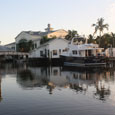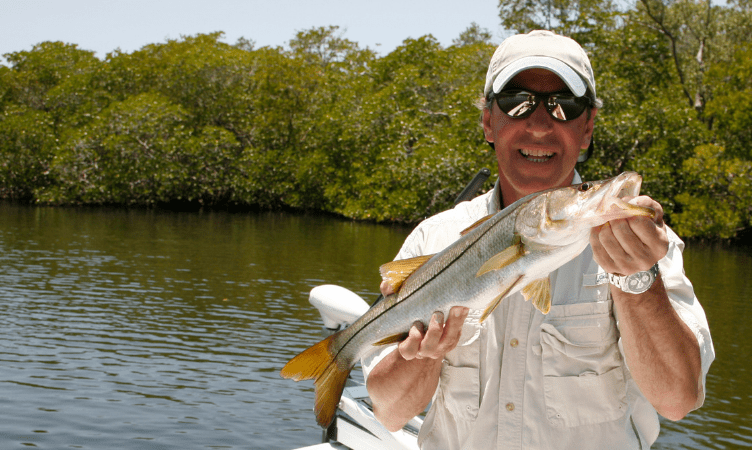
Posted by
When learning how to fish for snook in Florida, it’s important to set yourself up for success by making sure you’re using the right equipment, fishing in the right places, and following the proper rules. As one the most popular fish to catch in the sunshine state, Snook have a reputation not only for being delicious but for making for a memorable catch.
According to Florida Fish and Wildlife (FWC), anglers need a fishing license and snook permit to fish for snook in Florida. For the best chance of success, fish during the early morning and late evening hours. Snook prefer live bait, like pinfish, mullet and shrimp, or lures, like plugs, soft plastics and flair-hawk jigs.
Check out our guide to learn more about how to fish for snook in Florida, including where to find the best snook fishing spots, regulations you’ll need to follow, and more.
Where is the Best Snook Fishing in Florida?
The best place to fish for snook is a hotly debated topic among Florida fishermen. Regardless, no matter what coast of Florida you’re on, whether you prefer bridge, inlet, beach fishing, or something else entirely, there’s likely someplace nearby to find snook.
Some of the most popular snook fisheries in Florida include:
- Fort Myers
- Boca Grande
- Tampa Bay
- Sebastian Inlet
- Fort Pierce
- Miami
Where you choose to fish will likely depend on whether you visit the gulf or the Atlantic coast. Fortunately, you’ll have plenty of options to pick from no matter which you choose.
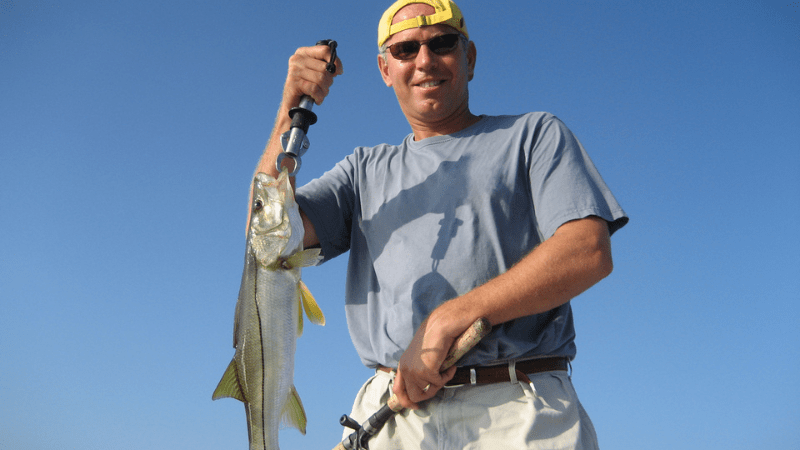
Snook Fishing on the Gulf Coast
If you’re looking to fish in Southwest Florida, there’s no better place to start than the waters around Fort Myers and all of its surrounding areas.
Here, the Caloosahatchee River empties into the Gulf of Mexico providing opportunities for fresh and saltwater fishermen alike. It’s also one of the reasons this area is so prime for snook fishing.
Snook aren’t too bothered by the changes in salinity, meaning you can find them while fishing the river or off the coast. Because snook are tropical fish, they tend to prefer warmer water. This makes them perfect for all of the inshore fishing that you can find near the surrounding waterways.
Just past Fort Myers, you can head into the San Carlos Bay to fish off of Fort Myers Beach and Estero Island. Just around the corner, you can fish around Pine Island, Captiva and Sanibel. This entire area is prime for snook fishing, providing opportunities for fishing from bridges and docks to mangroves and flats, and everything in between.
To the northwest, you’ll find Gasparilla Sound and Boca Grande. This area may be best known for its tarpon, but you can be sure to find plenty of snook in these waters as well. As far as trophy fishing goes, you could do far worse than to look for snook around Boca Grande.
A little further north you can fish the Tampa Bay. Snook are one of the area’s most popular fish. Similar to the Caloosahatchee, the Manatee River flows into these waters giving fishermen a chance to fish the brackish rivers and canals.
No matter where you head along Florida’s west coast, there’s a good chance you’re able to find a snook on the end of your line.
Snook Fishing on the Atlantic Coast
If you plan to fish the east side of the state, you’re unlikely to do better than Sebastian Inlet. Below Cape Canaveral and Cocoa Beach, these strings of islands and beaches offer plenty of opportunities for snook fishing.
Just like the gulf side, this inlet gives anglers the ability to fish the fresh and brackish waters of the St. Sebastian and Indian Rivers. If you’d prefer saltwater fishing, the Atlantic is right there as well. Either way, snook swim aplenty in these waters.
Further south, Fort Pierce offers a similar opportunity. The inlet in this area provides an opportunity for fishing the beaches and flats, or finding docks, bridges and other structures where snook tend to congregate. The entire Treasure Coast makes for a bountiful snook fishery.
If you happen to plan a trip down to Miami and the keys, you can find snook there too. The further south you go, the warmer the water you’ll find – which is exactly what snook like. Biscayne Bay provides plenty of opportunities to take a boat out onto, while the nearshore mangroves and grass flats are ideal for shore or kayak fishing in these parts.
What is the Best Bait for Snook?
Snook are hunting fish which means they like to gather near structures, like docks, bridges and mangroves to find their food. In order to catch snook, it’s best to go to one of those areas and use a bait similar to what the snook would be looking for. Some of the best live bait for catching snook includes:
- Pinfish
- Mullet
- Pilchards
- Croakers
- Shrimp
- Crabs
Really, anything relatively small will work just fine. If you’d like to opt for dead bait, using chunks or heads of mullet and ladyfish tend to work best. Alternatively, any of the above fish and crustaceans could work as dead bait too.
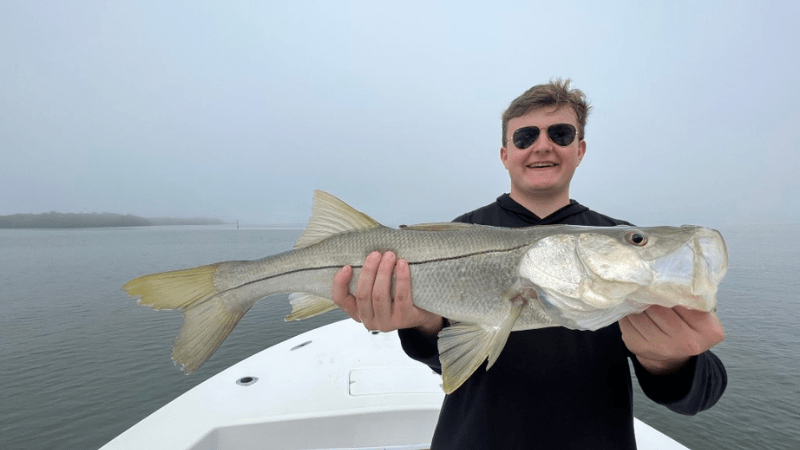
What is the Best Lure for Snook?
A couple of the most popular lures for fishing common snook include the MirrOLure Mirrodine and the DOA Shrimp. There are many lures that work for snook fishing, however. Topwater plugs, soft plastics and flair-hawk style jigs should all bring a bite.
Walk-the-dog style lures tend to work best for fishing closer to the surface. If you use a scented or an imitation lure, you should have even better luck.
If you’re fishing near bridges or in deeper water, you can’t go wrong with a flair hawk-styled jig. Cast up-current and bring it back slowly – about as fast as the water is flowing. Make sure you have a few different weights and colors depending on the strength of the current and the water conditions.
What Time of Day is Best to Catch Snook?
The best time of day to fish for snook is the early morning or late evening hours. Snook prefer low-light conditions and tend to feed during these times. This gives you the best chance to land a bite.
Alternatively, you could try your luck at night. Night fishing for snook in Florida is extremely popular. Because snook are nocturnal feeders, the late evening into the night hours can be very productive. Night fishing also provides a completely different and rewarding experience that you just can’t get fishing during the day.
Regardless, steer clear from the middle of the day and afternoon hours when fishing for snook. These are typically the least productive times of the day for snook fishing, and coincidently, the hottest and most uncomfortable.
Who Needs a Snook Stamp in Florida?
A snook stamp, otherwise known as a snook permit, is required by all individuals seeking to fish for snook.
You can buy an annual snook stamp for $10 for a year, or a five-year license for $50 (only for Florida residents). It’s important to note that this is in addition to a saltwater fishing license.
There are a few exceptions though. You do not need a snook permit if you:
- Hire a fishing charter
- Fish from a boat on which the captain owns a valid recreational saltwater vessel license
- Own a valid saltwater products license or FWC charter captain license
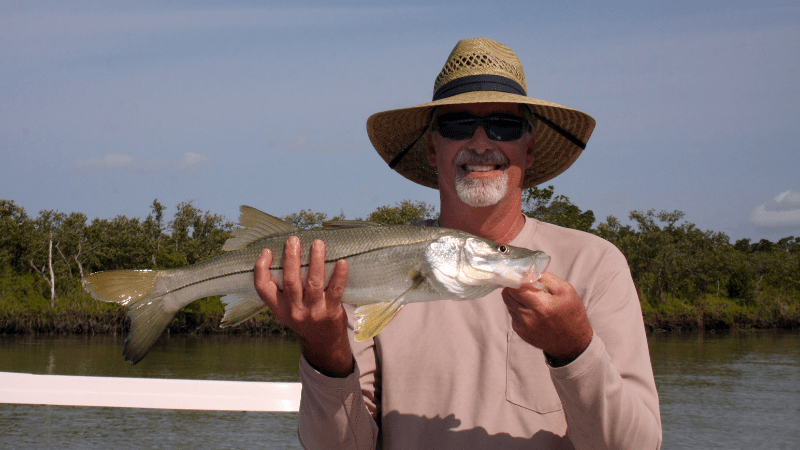
What are the Regulations on Snook in Florida?
Anglers seeking to fish for snook in Florida must obtain both a snook permit and a recreational fishing license (unless you fall into one of the above exceptions). Once you’re properly licensed, the allowable equipment for snook fishing is a hook and line.
In addition to that, you’ll have to be familiar with two different sets of regulations. These regulations are broken up between the waters of the Gulf and the Atlantic.
Atlantic Snook Fishing Regulations
On the Atlantic side, FWC regulations apply to the ocean, Lake Okeechobee, the Kissimmee River and other adjacent state and federal waters.
In these waters, the slot limit for snook is between 28 and 32 inches in length. That means that any snook that does not meet those criteria are ‘catch and release’.
There are two periods in which snook season is closed during the year:
- December 15 through January 31
- June 1 through August 31
Assuming you abide by the slot limit and snook season regulations, you’ll also be limited to only one snook per fisherman per day.
Gulf Snook Fishing Regulations
On the Gulf side, regulations apply to the Gulf of Mexico, Monroe County, Everglades National Park and any adjacent state and federal waters.
Here, the season is also closed during two time periods:
- December 1 through the end of February
- May 1 through August 31
The slot limit in these waters is just larger than on the Atlantic side – 28-33 inches in length. The daily bag is the same, however: one snook per fisherman per day.
Additionally, a couple of spots in Southwest Florida have their own fishing seasons. Tampa Bay and Sarasota Bay both run slightly different seasons than the rest of the Gulf. To stay up with current regulations, be sure to check with Florida Fish and Wildlife.
What is a Good Snook Rod and Reel?
The rod and reel that you choose to fish for snook will depend on a number of factors, like the strength of the current you’re fishing, the type of bait you use, and where you’re fishing from. However, the most important factor in determining what type of rod and reel you use is the size of snook you plan to catch.
Generally speaking, you’ll want to shoot for a 7-8-foot rod with medium strength. This should serve you well in the majority of cases and will provide a decent option whether you find a slot snook or something larger on your line.
When fishing a stronger current with live bait, or fishing deeper waters, you’re likely going to want to opt for a stronger rod and reel. This will give you more stability when fishing in more difficult conditions or when going after a larger fish.
For light currents and artificial baits or lures, choose a lighter rod. This will give you more sensitivity and allow you to feel out the bite a little easier. Be sure not to get too large a fish on your line though.
Now let’s get a little more specific. When fishing from a kayak and patrolling the shallow waters and grass flats, use a lighter setup. A 2500-3500 series with a 10-15-pound braid and a 20-pound leader should work in most situations.
If you plan on going after a large snook, or if you’re fishing from a bridge or dock, you’ll need to use a heavier rod and reel. Plan for a 4500-5500 series with a 40-plus-pound braid and 60-plus-pound leader. The larger the snook you’re after, the heavier leader you’ll need.
As stated before, the right rod and reel for you will depend on where and how you plan to fish for snook in Florida. Make sure you take all factors into account before deciding on your setup.
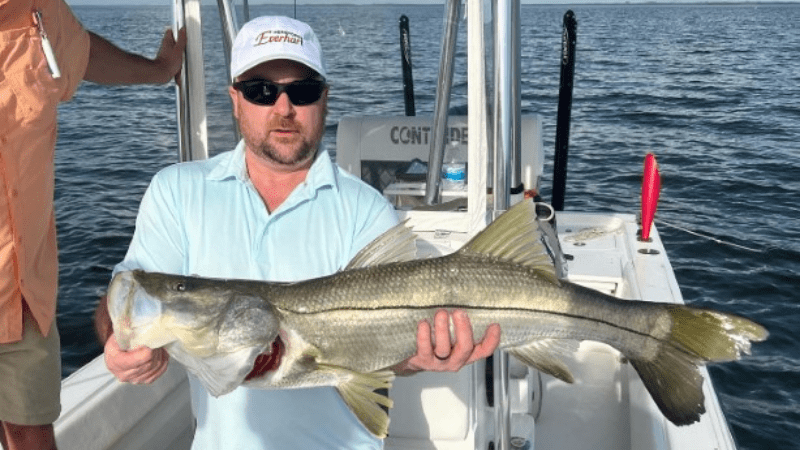
Book Your Snook Fishing Trip with Port Sanibel Marina
Now that you know how to fish for snook in Florida, start making your fishing plans with Port Sanibel Marina.
We offer boat and kayak rentals. These are perfect for exploring the local inlets or trawling near bridges, piers, or even the mangrove forests for snook and other fish.
If you’d rather get the help of an expert angler, we also offer charter services. Book a fishing trip and have a professional boat captain take you out onto the water for the best snook fishing of your life. Having a fishing guide by your side will not only provide a more catered experience, by likely net you more fish as well.
No matter what you have planned on your fishing trip, we can help. Give us a call at (239) 437-1600 and get started today!



